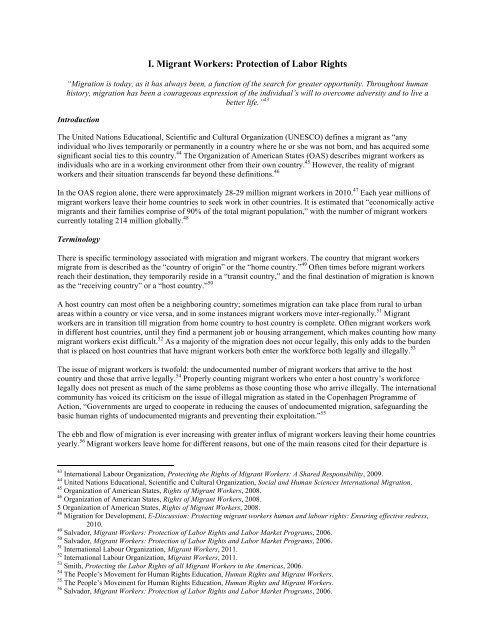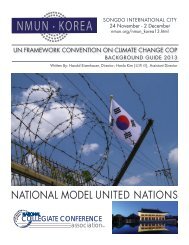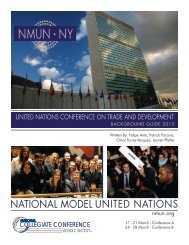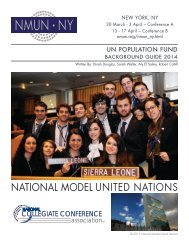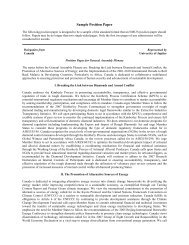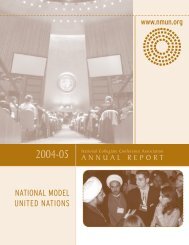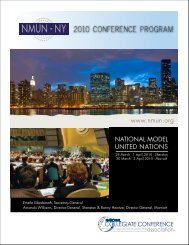Organization of American States - National Model United Nations
Organization of American States - National Model United Nations
Organization of American States - National Model United Nations
Create successful ePaper yourself
Turn your PDF publications into a flip-book with our unique Google optimized e-Paper software.
I. Migrant Workers: Protection <strong>of</strong> Labor Rights<br />
“Migration is today, as it has always been, a function <strong>of</strong> the search for greater opportunity. Throughout human<br />
history, migration has been a courageous expression <strong>of</strong> the individual’s will to overcome adversity and to live a<br />
better life.” 43<br />
Introduction<br />
The <strong>United</strong> <strong>Nations</strong> Educational, Scientific and Cultural <strong>Organization</strong> (UNESCO) defines a migrant as “any<br />
individual who lives temporarily or permanently in a country where he or she was not born, and has acquired some<br />
significant social ties to this country. 44 The <strong>Organization</strong> <strong>of</strong> <strong>American</strong> <strong>States</strong> (OAS) describes migrant workers as<br />
individuals who are in a working environment other from their own country. 45 However, the reality <strong>of</strong> migrant<br />
workers and their situation transcends far beyond these definitions. 46<br />
In the OAS region alone, there were approximately 28-29 million migrant workers in 2010. 47 Each year millions <strong>of</strong><br />
migrant workers leave their home countries to seek work in other countries. It is estimated that “economically active<br />
migrants and their families comprise <strong>of</strong> 90% <strong>of</strong> the total migrant population,” with the number <strong>of</strong> migrant workers<br />
currently totaling 214 million globally. 48<br />
Terminology<br />
There is specific terminology associated with migration and migrant workers. The country that migrant workers<br />
migrate from is described as the “country <strong>of</strong> origin” or the “home country.” 49 Often times before migrant workers<br />
reach their destination, they temporarily reside in a “transit country,” and the final destination <strong>of</strong> migration is known<br />
as the “receiving country” or a “host country.” 50<br />
A host country can most <strong>of</strong>ten be a neighboring country; sometimes migration can take place from rural to urban<br />
areas within a country or vice versa, and in some instances migrant workers move inter-regionally. 51 Migrant<br />
workers are in transition till migration from home country to host country is complete. Often migrant workers work<br />
in different host countries, until they find a permanent job or housing arrangement, which makes counting how many<br />
migrant workers exist difficult. 52 As a majority <strong>of</strong> the migration does not occur legally, this only adds to the burden<br />
that is placed on host countries that have migrant workers both enter the workforce both legally and illegally. 53<br />
The issue <strong>of</strong> migrant workers is tw<strong>of</strong>old: the undocumented number <strong>of</strong> migrant workers that arrive to the host<br />
country and those that arrive legally. 54 Properly counting migrant workers who enter a host country’s workforce<br />
legally does not present as much <strong>of</strong> the same problems as those counting those who arrive illegally. The international<br />
community has voiced its criticism on the issue <strong>of</strong> illegal migration as stated in the Copenhagen Programme <strong>of</strong><br />
Action, “Governments are urged to cooperate in reducing the causes <strong>of</strong> undocumented migration, safeguarding the<br />
basic human rights <strong>of</strong> undocumented migrants and preventing their exploitation.” 55<br />
The ebb and flow <strong>of</strong> migration is ever increasing with greater influx <strong>of</strong> migrant workers leaving their home countries<br />
yearly. 56 Migrant workers leave home for different reasons, but one <strong>of</strong> the main reasons cited for their departure is<br />
43<br />
International Labour <strong>Organization</strong>, Protecting the Rights <strong>of</strong> Migrant Workers: A Shared Responsibility, 2009.<br />
44<br />
<strong>United</strong> <strong>Nations</strong> Educational, Scientific and Cultural <strong>Organization</strong>, Social and Human Sciences International Migration.<br />
45<br />
<strong>Organization</strong> <strong>of</strong> <strong>American</strong> <strong>States</strong>, Rights <strong>of</strong> Migrant Workers, 2008.<br />
46<br />
<strong>Organization</strong> <strong>of</strong> <strong>American</strong> <strong>States</strong>, Rights <strong>of</strong> Migrant Workers, 2008.<br />
5 <strong>Organization</strong> <strong>of</strong> <strong>American</strong> <strong>States</strong>, Rights <strong>of</strong> Migrant Workers, 2008.<br />
48<br />
Migration for Development, E-Discussion: Protecting migrant workers human and labour rights: Ensuring effective redress,<br />
2010.<br />
49<br />
Salvador, Migrant Workers: Protection <strong>of</strong> Labor Rights and Labor Market Programs, 2006.<br />
50<br />
Salvador, Migrant Workers: Protection <strong>of</strong> Labor Rights and Labor Market Programs, 2006.<br />
51<br />
International Labour <strong>Organization</strong>, Migrant Workers, 2011.<br />
52<br />
International Labour <strong>Organization</strong>, Migrant Workers, 2011.<br />
53<br />
Smith, Protecting the Labor Rights <strong>of</strong> all Migrant Workers in the Americas, 2006.<br />
54<br />
The People’s Movement for Human Rights Education, Human Rights and Migrant Workers.<br />
55<br />
The People’s Movement for Human Rights Education, Human Rights and Migrant Workers.<br />
56<br />
Salvador, Migrant Workers: Protection <strong>of</strong> Labor Rights and Labor Market Programs, 2006.


